#{plotting}
Explore tagged Tumblr posts
Text
suspicious ass cat…

#scheming#plotting#he knows#He’s just standing there… menacingly#dumbass#if anything happens to him i will kill everyone and then myself#i love this so much#my shaylaaaa
3K notes
·
View notes
Text

Me (plotting and scheming)
294 notes
·
View notes
Text
Writing Tools for Planning Your Story
I've tried tons of writing apps and sites, so you don't have to. Here's a list of free sites to plot out your novel, with my review and some images of how I use it.
Milanote
Milanote is like having a giant pinboard with folders. You can upload anything onto it [yes even your main doc] and then draw over it or connect things with lines and arrows
Milanote lets you add up to a hundred things for free, not including drawing. This is one of the downsides of the site as I've found myself reaching that limit recently.
For me, the best part is being able to draw over stuff, and the color swatches.
Milanote is a lot less structured than other sites I've used, and personally, I don't think their templates are worth using.
8/10 overall, Milanote is what I mainly use. Here are some pics of how I use it:
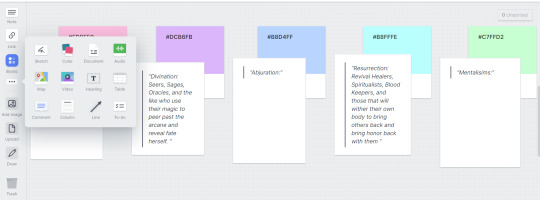
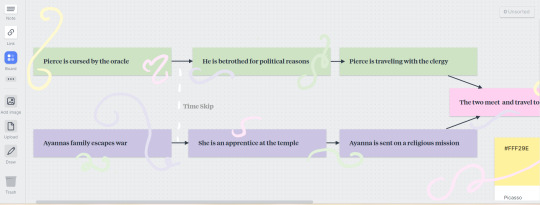
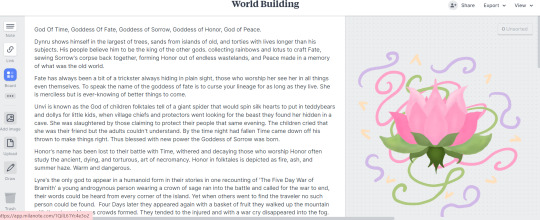
Miro
Miro is a flowchart website mainly used for corporate jobs, however, it can be a great plotting tool for that reason
Miro has a lot of great starter templates if you are looking for a more structured freeform experience. It also comes with a blank page as well.
Unfortunately, I'd argue that it's a bit of a hard tool for beginners to use without a template, I've learned copy-paste is my best friend with Miro the hard way.
It's much better than most platforms at making timelines though.
It has a limit of three boards which is a bit disappointing but overall, I think it's worth the try.
5/10 Miro is very middle of the road for me due to the limited ability to customize things and the free limit. Here are some pics:
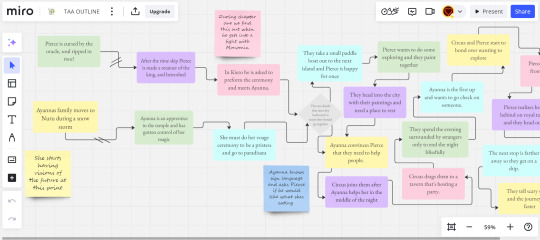
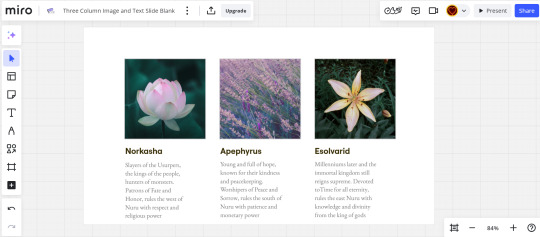
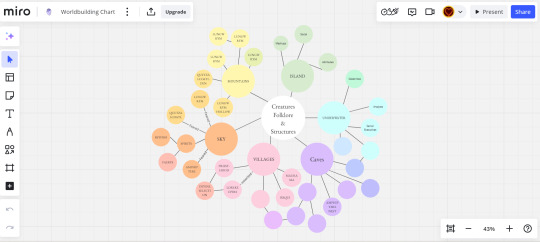
[I wrote that part weeks ago, I am now fully using Miro and believe it's the best for making timelines and charts, I just wish it let me make more boards 8/10]
Hiveword
This might be someone's jam, I can't really say it's mine though.
First off, the unpaid version is really just a few boxes saying "Write a summary here." which makes it just not worth it in my opinion
There really isn't any way to customise things which is my favorite part of most of these softwares
I've barely used this, so maybe there's something I'm missing but
1/10, Just use Google Docs at this point, here's a couple pics
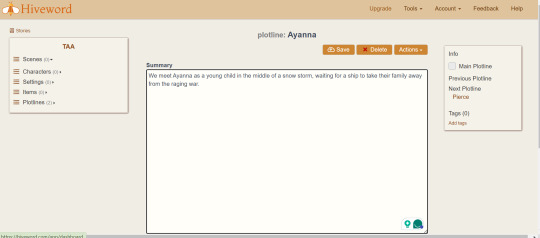

World Anvil
People like this software, it's mainly used for tabletop, which is just a different way of writing adventure, and I've seen it recommended by authors.
Unfortunately, I'm going to disagree with a lot of people and say it's hard to use and isn't even really good at plotting.
I may be biased on this one as every time I've tried to use it in the past I've struggled. However, it seems like another just write it in a document and create a folder.
I'd say it's closer to an organizing tool, but even then just use something else.
3/10, I have nothing to say about it but maybe you'll enjoy it, all here are two photos
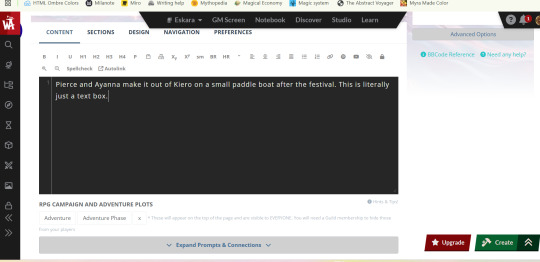

Campfire
This is the one I think I've heard the most about, but have never actually tried.
right off the bat, I'm going to say this is 100% worth it, you'll see at the end with the photos but this is like if Miro and World Anvil had an organization baby.
It's extremely easy to understand, and it makes timelines, it's more for writing your whole book but idk about that yet.
7/10, its themes are really pretty but it limits how much you can do to 20 I believe. Here are the photos
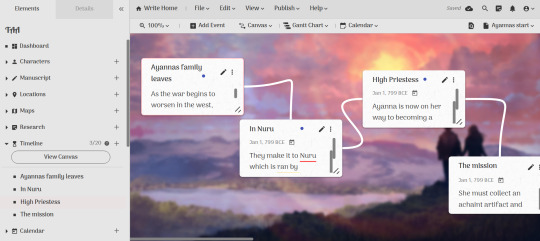
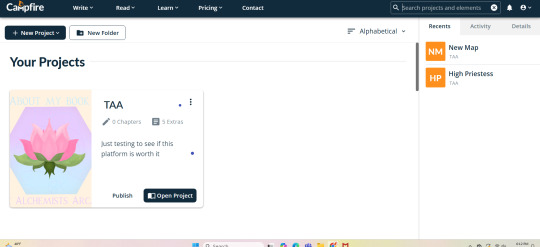
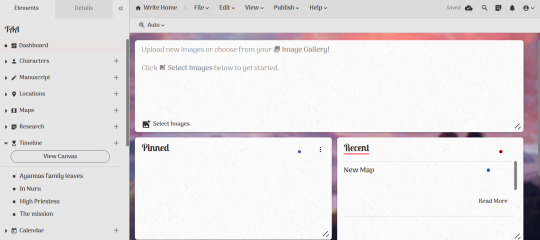
That's all for now, honestly, I think you should use Miro if you are looking to plot things out, and Milanote if you want to collect and organize your thoughts for writing, as that's what I do. Obviously what I like won't be for everyone, but hopefully, this helped you see some options
#writeblr#writers on tumblr#creative writing#worldbuilding#plotting#writing advice#writing tool#writing#writers#writing plans
1K notes
·
View notes
Text

#loki smut#loki x reader smut#marvel smut#smut#x reader#one shot#drabble#marvel#the avengers#marvel mcu#marvel cinematic universe#mcu#writers#writers on tumblr#writerscommunity#ao3 writer#plotting#plot problems#writing advice#writing tips#descriptions
443 notes
·
View notes
Text
What To Do About Filler
I am deeply frustrated at the increasing usage of the concept of "filler" in writing, partly because how people are using it is completely separated from what it usually means, and partly because few people explain what they actually mean when a story lacks "filler."
So, in short, when this comes up, what people usually are talking about is:
A lack of subplots. Subplots are essential background to developing your story beyond the main action points. Subplots include romantic storylines, internal journeys (learning to deal with a trauma, for example), plots that are critical for secondary characters, etc.
No room to breathe (aka pacing). Keeping up the tension is a common piece of advice, but if every single scene is filled with tension, you're going to exhaust the reader (and yourself). Quieter moments allow characters to reflect, realize things (like feelings for each other), and give you space to establish worldbuilding and mood.
Rushed or missing character development. Giving your characters space to learn things about themselves, confess or realize feelings, and moments to make decisions and change are essential to a story. Defeating the big bad is important, but usually the inner strength to do so comes from the character changing over the course of the story.
I am losing the battle against using the word filler when you mean a story lacks other things. Other than shaking my fist at the youths, I suggest that if you get feedback about "filler," see if you can get specifics. Is it an issue with pacing? Character developments? Not enough description or worldbuilding? If a romance seemed rushed, at what points does the reader think there should be more interaction? Etc.
A note for fanfic writers: Your goals are often different from someone writing to publish, but hammering down what filler means can still help you as well. Narrowing down the point of your story ("in this drabble, these characters flirt without using words" or "sexy coffeeshop AU") and making sure to ask your beta readers if what you're writing fulfills that goal can help you figure out if your story is making the impact you want.
942 notes
·
View notes
Text
That brilliant plot idea I had at 3 AM when I try to remember it.
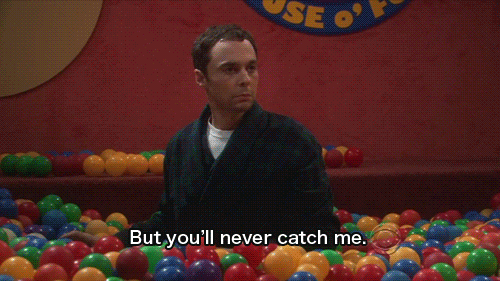
#writblr#writers on tumblr#writing community#writers of tumblr#plot writing#plotting#writer#writers#writing#writing meme#writing humor#creative writing#creative writers#queue
1K notes
·
View notes
Text
Opposing Qualities for your Characters!
I always advocate the concept of Traits and their Inverses when making characters. If you're familiar with my blog, you'll know that in one of my posts, I've told you to use opposing qualities when you make a character to make them real. Here's a link to that post if you haven't come across it yet so you can understand this better: https://www.tumblr.com/coffeetank/747126821111447552/build-characters?source=share ~ List of more opposing qualities to give your characters: persuasive :: manipulative (your character has a way with words and sometimes uses this to get away with things)
humble :: underconfident (your character does not have an ego at all, but they are in actuality always underconfident - show how this can affect their surroundings especially in a situation where others depend on them)
independent :: alienated (your character can do everything on their own and quite literally does not need anyone around, show how this can crossover over with alienation - dig into the emotional background of this supposed crossover)
curious :: invasive (your character has an appetite for knowledge, but they forget boundaries - show how this can get them into trouble)
daring :: reckless (your character has a strong spirit and isn't scared of taking risks, but this can always incline to the bad side and cause them harm - use this to especially add event and conflict in the story)
neutral :: retracted (your character prefers to see both sides before coming to a conclusion and stays neutral 99% of the times, but then when one side needs them more than the other they refuse to acknowledge that need and pull themselves out of that situation - show how this this can affect their relationships with other people especially on a moral ground)
emotional :: irrational (it's always good for your character to have emotional capacity, but it can hinder with their practical side for sure - show how this plays out)
unique :: aberrant (your character has a very solid personality but then some their quirks are too odd to be normal - this is good for revealing an undercover villain/agent/supernatural being later in the story as a twist)
optimistic :: unserious (your character is a positive person, but they take life too lightly sometimes - play with it!)
appealing :: deceptive (your character is absolute delight to be around and wins hearts in an instant - show how they use this power of their to deceive people for their own benefit)
hopeful :: expectant (your character wishes for the bright side - show how this can transverse into having unfulfilled expectations thus making them act out wrongly due to disappointment)
clever :: cunning (as obvious as it sounds, your character uses their intelligence for the wrong - bonus if you mix this with another set of opposing qualities to add depth and layers to your characters)
short-tempered :: violent (easy, simple and impactful; your character loses temper quickly but they damage things around them with every small/big outburst)
Feel free to use these as you'd like! I'll bring you more soon.
-ashlee
#writers on tumblr#writerscommunity#writing#writer#books#write#writingtips#creative writing#fanfic writing#fanfic#drabbles#tips#tricks#tips and tricks#writing advice#writing ideas#characters#fictional characters#character sheet#character creation#plotting#urban fantasy#tropes#original characters#oc#fiction#author#fiction stories#writing prompt#writing blog
628 notes
·
View notes
Text

#How to Plot and Plan From the Comfort of Any Chair#tips#tricks#life hacks#helpful hints#advice#plotting#planning#plot#plan#pots#pans
476 notes
·
View notes
Text
✨ reblog if you want some aesthetic setting moodboards for your writing inspiration ✨
#writeblr#creative writing#writers on tumblr#writerscommunity#fiction#character development#writing prompt#dialogue prompt#female writers#writer blog#academia aesthetic#aesthetic#moodboard#setting inspirations#inspired writing#writing inspiration#fiction writing#writing community#writing life#writers#writer#novel writing#writing#writer life#tumblr writers#writerslife#writer stuff#moodboards#setting idea#plotting
165 notes
·
View notes
Text
Plot twists are so hard to write. I want readers to be completely taken by surprise but also slightly frustrated they didn't figure it out because it was so obvious. I want to shift their entire perspective of my narrative. I want all the hints to perfectly line up, creating something so mind blowing that the ending leaves people speechless. How do I make it so that my plot twist doesn't seem contrived, or too obvious, or completely out of the blue?
#plot twists#writing#creative writing#writers#writeblr#writers on tumblr#writing problems#writing is hard#plot problems#plotting
71 notes
·
View notes
Text

Have we done this one yet?
#bc it fits them so well lol#downton abbey#sarah o'brien#thomas barrow#siobhan finneran#robert james collier#rob james collier#miss o'brien#evil gay besties#evil cigarettes#smoking#plotting#downtonedit#thomas and o'brien
227 notes
·
View notes
Note
What do I do when the characters have chosen to go somewhere that makes sense, but leads absolutely nowhere?
I know exactly what you mean, and fixing it is certainly not impossible. It's pretty natural, especially if you're a pantser, to have your characters end up in a situation that wipes out all the tension. (It's easy to fall into this as a plotter too, so beware.) What you need to do is turn up the pressure in the plot, both externally and internally.
Possible Problem 1: Your Characters Are Too Comfortable. If your characters don't have enough internal conflict going on, they might just not want to move forward with the plot. This is a really easy hole to fall into (for all the stereotypes of writers tormenting their characters, I find it's much harder not to pull punches, especially with the first draft). Drive up that internal conflict within the characters and with each other. Laying down a subplot about an unrequited crush or a secret identity that implodes right when your characters feel safe can help get them going again. An argument between characters that causes them to do something reckless might be the catalyst you need.
Possible Problem 2: Not Enough Plot Tension. If your characters have lost steam, they may be in the wrong place. You may need to ramp up the danger by backtracking in the plot to lay down more external pressure to keep the characters going. A ticking clock fueled by the need to cure a deadly disease, a looming threat that's on their heels. If your characters still end up in a spot that too easily solves their problems, cut them off from getting there! The pass collapses, forcing them through the shadowy woods instead.
Possible Problem 3: You Don't Have the Next Plot Point Lined Up. If you're pantsing and are stuck (or if your outline isn't working), sometimes you just gotta take a moment to figure out where your characters actually need to be next and jump to that point. Sometimes writing out the next big scene will help you figure out how to build the connective tissue between them. Sometimes you will write "fix this later" and curse your past self into oblivion. We've all been there.
Possible Problem 4: You Might Just Need a (Short) Break. Truly stuck? Inspiration often strikes when you take your mind off the issue. Go for a walk, play a video game, try not to think of your writing issue for a couple of days. You'll likely realize the solution in the middle of doing something else.
Now, all of these techniques are for writing a story or a novel. If you're plotting out a game, you may just need to drop a Big Bad in the middle of things to force your characters into action. (Hell, you may need to do that for your novel too.) The most important thing is that no matter how clunkily you fix it, you can always go back and smooth over those rough parts with the power of hindsight.
318 notes
·
View notes
Note
Do you have any posts on turning a book into a series, and/or deciding how many books the series should be? I searched but couldn't really find anything. Im plotting my story and not sure how to split it up into how many books if I decide it's too much for a stand alone. Do I just go with trilogy? Thought there are many authors who have like 5-10 books. How do I know?
The choice between writing a standalone novel or committing to develop a series isn’t always straightforward. While some stories naturally lend themselves to multiple books, others work best as self-contained narratives. So what do you have to think about to actually make these decisions?
Signs your story might work better as a series
Complex worldbuilding
If you’ve built an intricate fictional world with multiple cultures, magic systems, or technological innovations that you can’t fully explore in a single book without overwhelming readers, you might have series potential.
Multiple major story arcs
When you have several significant plotlines that feel rushed or cramped into one book, or story threads that naturally extend beyond your story’s major conflict, this could show series potential.
Character development opportunities
If your characters have growth trajectories that would feel unrealistic or rushed within a single book, or if you have multiple interesting characters whose stories deserve more content, a series might be best.
Scope of conflict
Stories with conflicts that escalate naturally or reveal larger implications beyond the initial problem often work well as series.
Signs your story might work better as a standalone
Single central conflict
If your story revolves around one main conflict that can be satisfyingly resolved in a single book, it might be better as a standalone.
Focused character arc
When your protagonist’s journey has a clear beginning, middle, and end that rarely spawns new questions or conflicts, consider keeping it standalone.
Contained story world
If your world-building serves the immediate story without requiring extensive exploration of other aspects, it might not need expansion into a series.
Thematic resolution
When your theme can be fully explored and resolved in one book, forcing it into a series might dilute its impact and spread the story too thin to remain interesting.
How to decide the number of books
If you’ve decided your story would work better as a series, consider these factors when deciding length:
Natural breaking points: Look for places where your story has significant shifts in conflict, setting, or character development.
Story complexity: More complex narratives might need more books to do justice to all the elements.
Market considerations: While you shouldn’t write for marketing alone, if you plan to publishing, be aware that publishers and audiences often prefer certain series lengths for different genres.
Story structure: Some narratives naturally fall into traditional structures:
Trilogy (three acts)
Duology (two-part story)
Quartet (four interconnected arcs)
Longer series (episodic adventures or expanding scope)
Questions to ask yourself
Can your story be told effectively in one book without sacrificing depth or rushing important elements?
Do you have enough material for multiple books without resorting to filler?
Are your subplots and secondary characters strong enough to sustain reader interest across multiple books?
Does each potential book have its own complete arc while contributing to the larger story?
Are you personally invested enough in the world and characters to spend years developing multiple books?
Remember that there’s no universally “right” answer. Some stories that started as standalone books often grow into series (think crime series that tell self-contained stories but use the same protagonist throughout), while others that originally released as series are often condensed into a single volume for a better reader experience (like Ursula Le Guin’s Earthsea Quartet, or Susan Cooper’s The Dark Is Rising series).
Let your story guide you. Don’t force a standalone into a series just because series are popular, and don’t compress a story that needs room to breathe just to fit it into one book. Focus on telling your story in the most effective way possible, and the right format will often become clear during the writing process.
Whether you choose to write a standalone book or a series, make sure each book can stand on its own merits while serving the larger story you want to tell.
#writeblr#writing tips#writing advice#writing resources#writing community#writers#writing#creative writing#writers of tumblr#creative writers#writing help#writing inspiration#writerblr#ask novlr#plotting#plotting tips
62 notes
·
View notes
